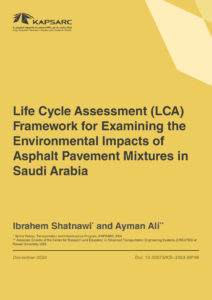Decarbonization Pathways for Asphalt Pavement Mixtures in Saudi Arabia: A Life Cycle Assessment Approach
This study conducts a cradle-to-gate life cycle assessment (LCA) of asphalt mixtures in the Kingdom of Saudi Arabia (KSA). It focuses on assessing the environmental impacts of asphalt mixtures produced with and without reclaimed asphalt pavement (RAP), as well as the use of warm mix asphalt (WMA) technologies to help reduce mixing temperatures. The study also assesses the sensitivity of asphalt mixtures’ environmental impacts (primarily global warming potential – GWP) to changes in transport distances for aggregates and binder (the two main constituents of an asphalt mix), the replacement of oil- or natural gas-produced electricity with solar electricity, and the substitution of diesel burner fuel with natural gas.
11th June 2025
